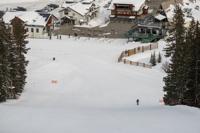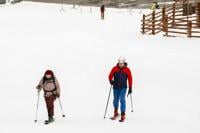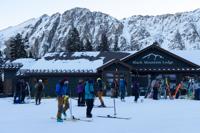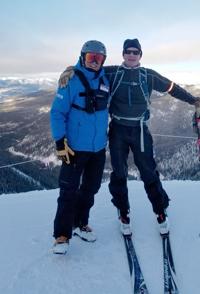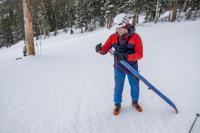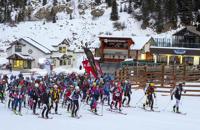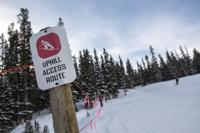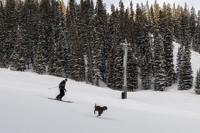Uphill skiing and snowboarding is ‘community through skinning’ at Colorado’s ski resorts
Uphill skiing and snowboarding at any of the 27 Colorado ski areas that offer it truly defines fun, fitness and community.
And one person who knows uphilling well is Summit County resident Gina Asaorino.
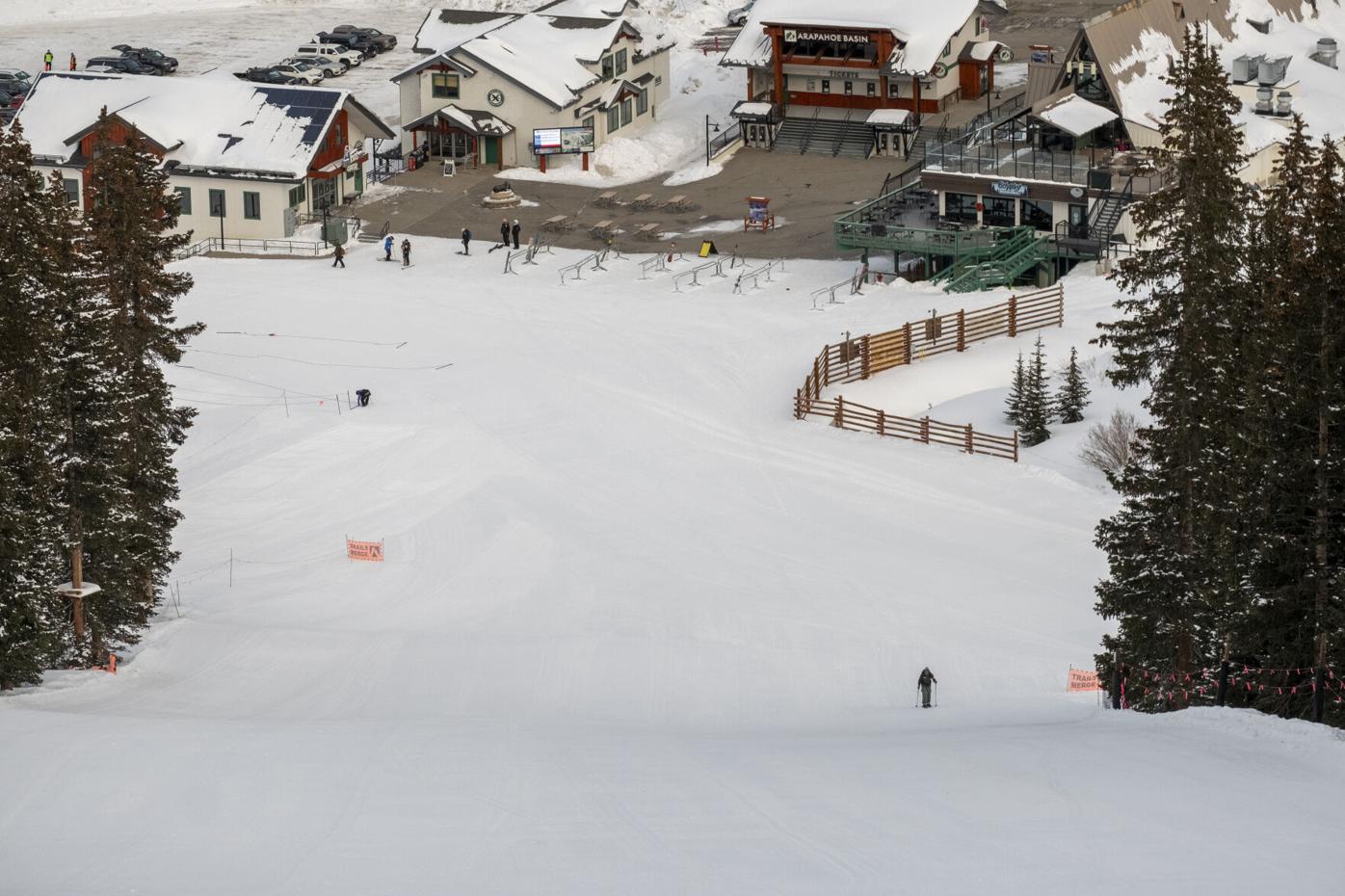
Gina Asaorino uphill skins on High Noon trail Tuesday, Feb. 10, 2025 at Arapahoe Basin Ski Area in Keystone, Colorado.
Jonathan Ingraham jonathan.ingraham@denvergazette.com

Gina Asaorino uphill skins on High Noon trail Tuesday, Feb. 10, 2025 at Arapahoe Basin Ski Area in Keystone, Colorado.
Asaorino has been uphill skiing at Arapahoe Basin for over 30 years, she said, and has seen the number of people who do the same grow.
‘Uphilling’ or ‘skinning’, is the action of climbing a mountain on skis or a splitboard-snowboard using skins — a nylon fabric that grips to the snow — for traction.
When Asaorino started skinning, she would head up with a group of girls and hang out at the lodge near the summit before skiing back down. Skinning to the top was free then, she said.
“It used to just be a group of us girls skinning up in our Telemark gear, and now there’s a lot more people out here, which is fine,” she said.
As the number of people uphilling has changed, so has the variety, she added, saying that now she sees everything from novice uphill skiers taking on the challenge to “uber fit” people with ultralight gear running laps.
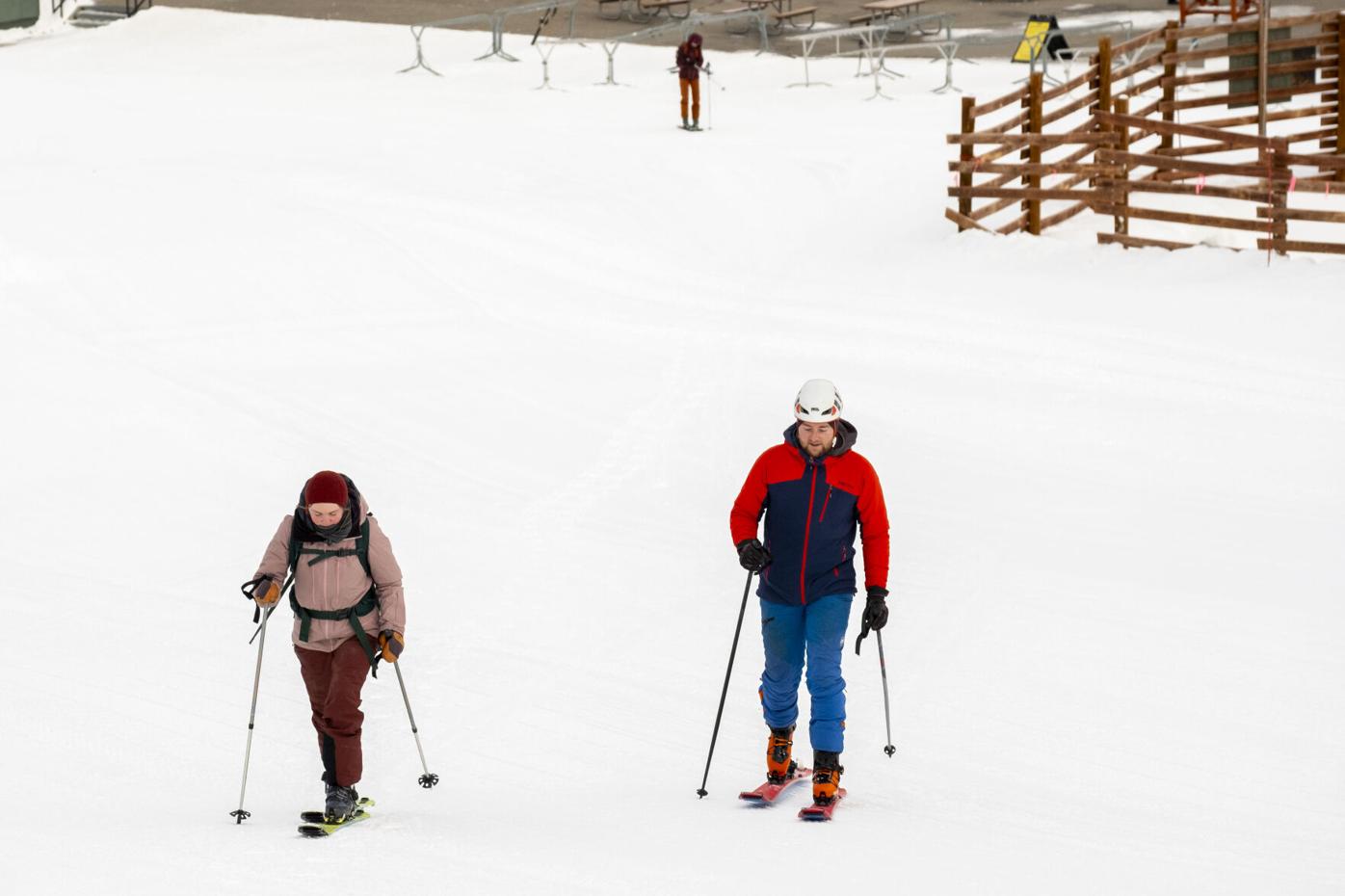
Kyla Pearce, left, and Shawn Heyland ski uphill toward High Noon trail Tuesday, Feb. 10, 2025 at Arapahoe Basin Ski Area in Keystone, Colorado.
Jonathan Ingraham jonathan.ingraham@denvergazette.com

Kyla Pearce, left, and Shawn Heyland ski uphill toward High Noon trail Tuesday, Feb. 10, 2025 at Arapahoe Basin Ski Area in Keystone, Colorado.
Nowadays, Asaorino mostly comes to Arapahoe Basin to ski solo. She’s also swapped the Telemark gear for alpine touring gear, meaning she can lock her heel in to ski back downhill once she gets to the top.
“I usually come two or three times a week,” she said. “I like to get my cardio in before I ski.”
At the top, where there once was a room she and her friends could relax in before skiing back down, there is now a restaurant that sometimes serves early uphillers breakfast.
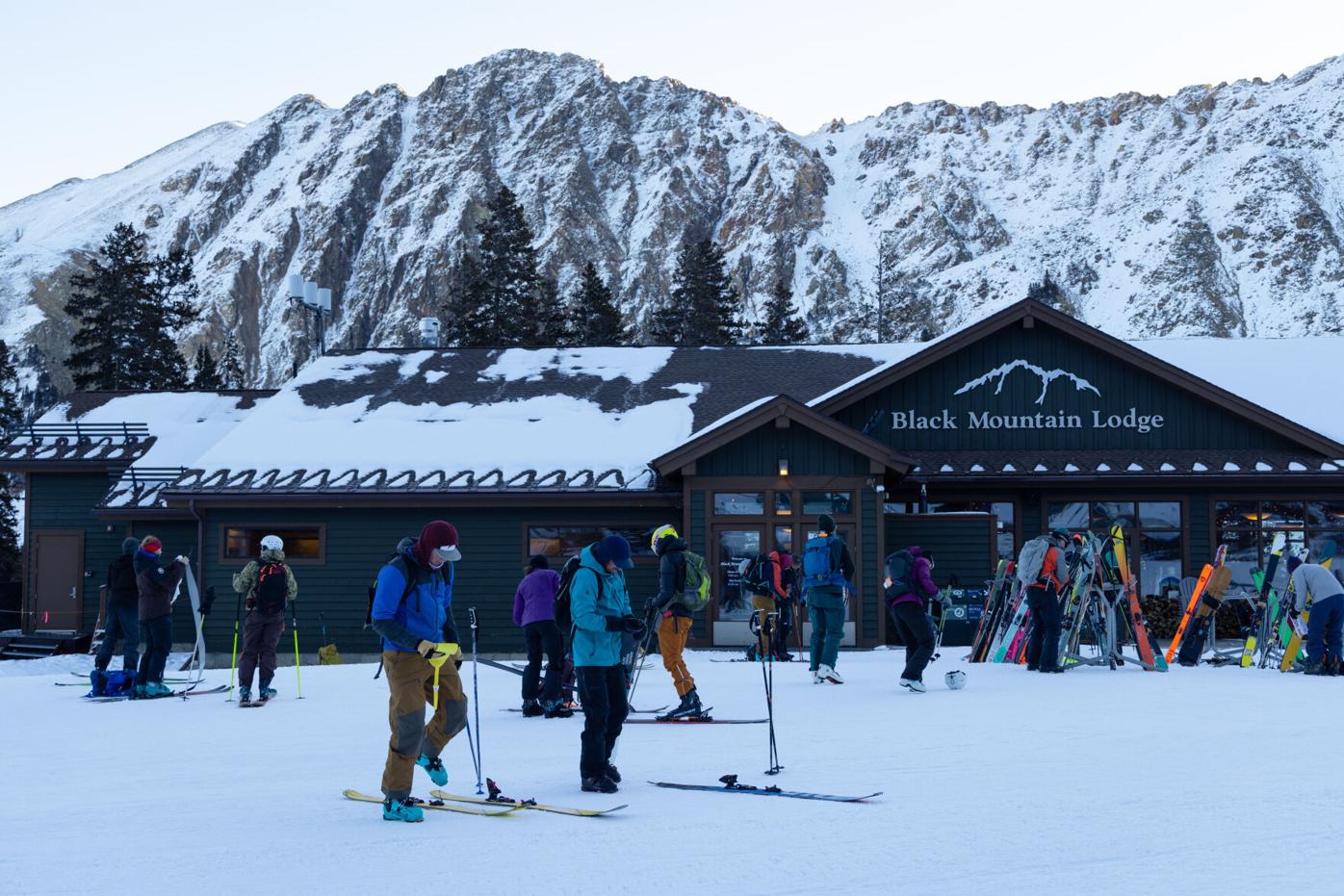
Uphill skiers depart their gear for an Uphill & Chill Breakfast event at the Black Mountain Lodge Sunday, Nov. 10, 2024 at Arapahoe Basin Ski Area.
Courtesy photo, Lucas Herbert, Arapahoe Basin Ski Area

Uphill skiers depart their gear for an Uphill & Chill Breakfast event at the Black Mountain Lodge Sunday, Nov. 10, 2024 at Arapahoe Basin Ski Area.
While a lot has changed, Asaorino isn’t bothered by the increase in uphill traffic. In fact, she enjoys it.
“Things change, but I’m glad people are enjoying it,” she said.
Colorado’s uphill-skiing community first started hiking up Arapahoe Basin in droves sometime circa 2015, or at least that was when it started becoming noticeable to the Front Rangers.
But before that, Patrick O’Sullivan, former Arapahoe Basin director of safety and risk, used to watch early pioneers, like Asaorino, ‘earn their turns’ while he was working in ski patrol.
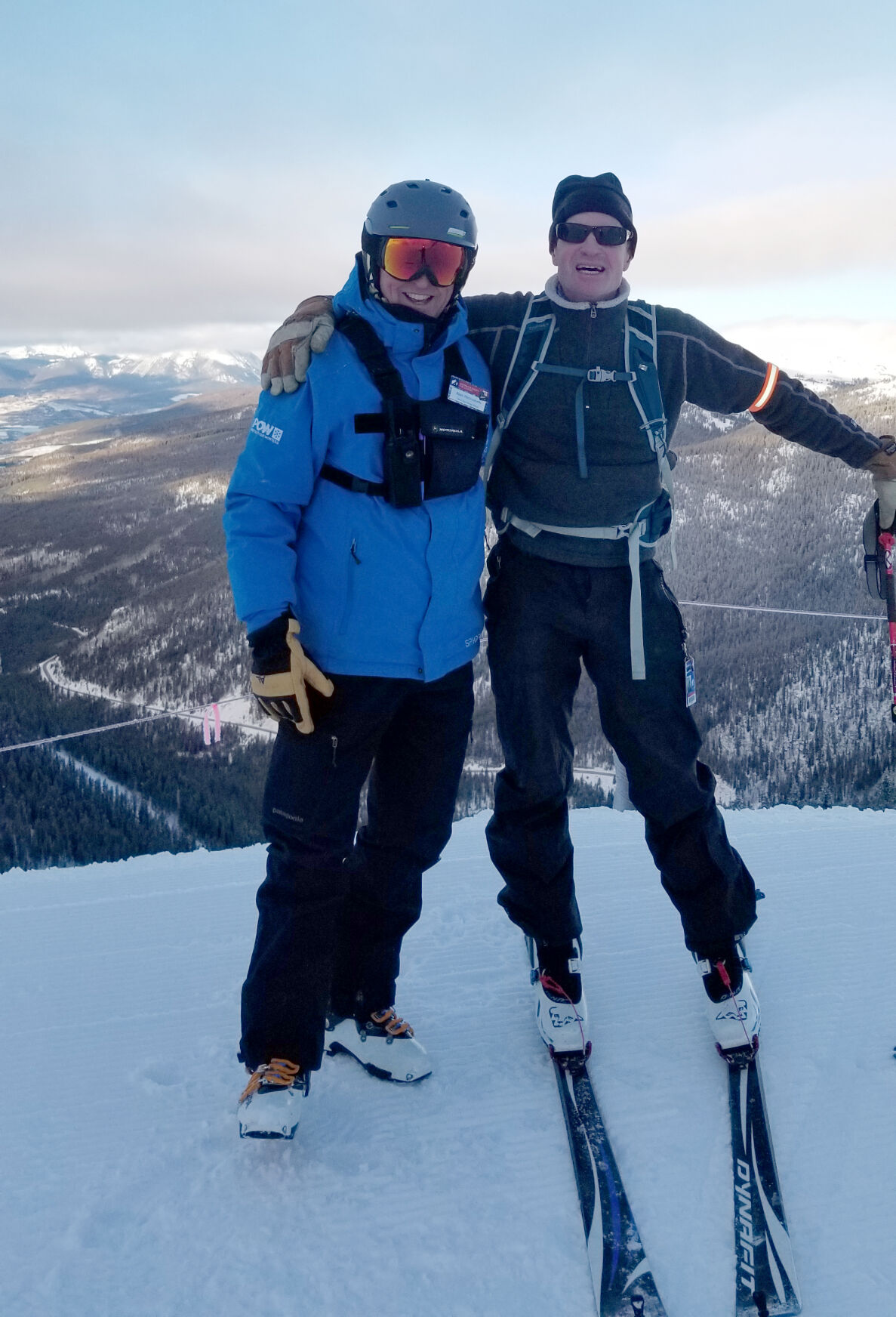
Alan Henceroth, COO of Arapahoe Basin Ski Are and EMGT partner Marc Doucette atop the ski area summit.
Courtesy, Patrick O'Sullivan

Alan Henceroth, COO of Arapahoe Basin Ski Are and EMGT partner Marc Doucette atop the ski area summit.
“There was nobody really doing it hardly,” O’Sullivan said of the uphill skiers hiking the slopes in the early 2000s. “We’d be doing control work on the upper mountain and there’d be a couple guys we knew skinning up there with Telemark gear – and there might be roots before that – but that’s my first memory.”
O’Sullivan would watch these die-hard skiers hike the slopes and look for powder lines to ski at the resort before and after regular operating hours. They would intermingle with the snowcats grooming the trails while laying skin tracks of their own, not realizing they were building a foundation for an entirely new activity dozens would do daily.
Uphill skinning using Telemark skis was about the only way to uphill ski then since Alpine Touring (AT) setups were still in their infancy. People did snowshoe on the resort’s slopes as well, but without the rush of powder snow skiing on the way back down, they were merely hikers enjoying the quiet and easy access before the ski crowds arrived.
Telemark skiing’s dominance peaked in the late 1990s, and by the early 2000s AT setups had become all the rage, as gear became lighter, more durable and cheaper.
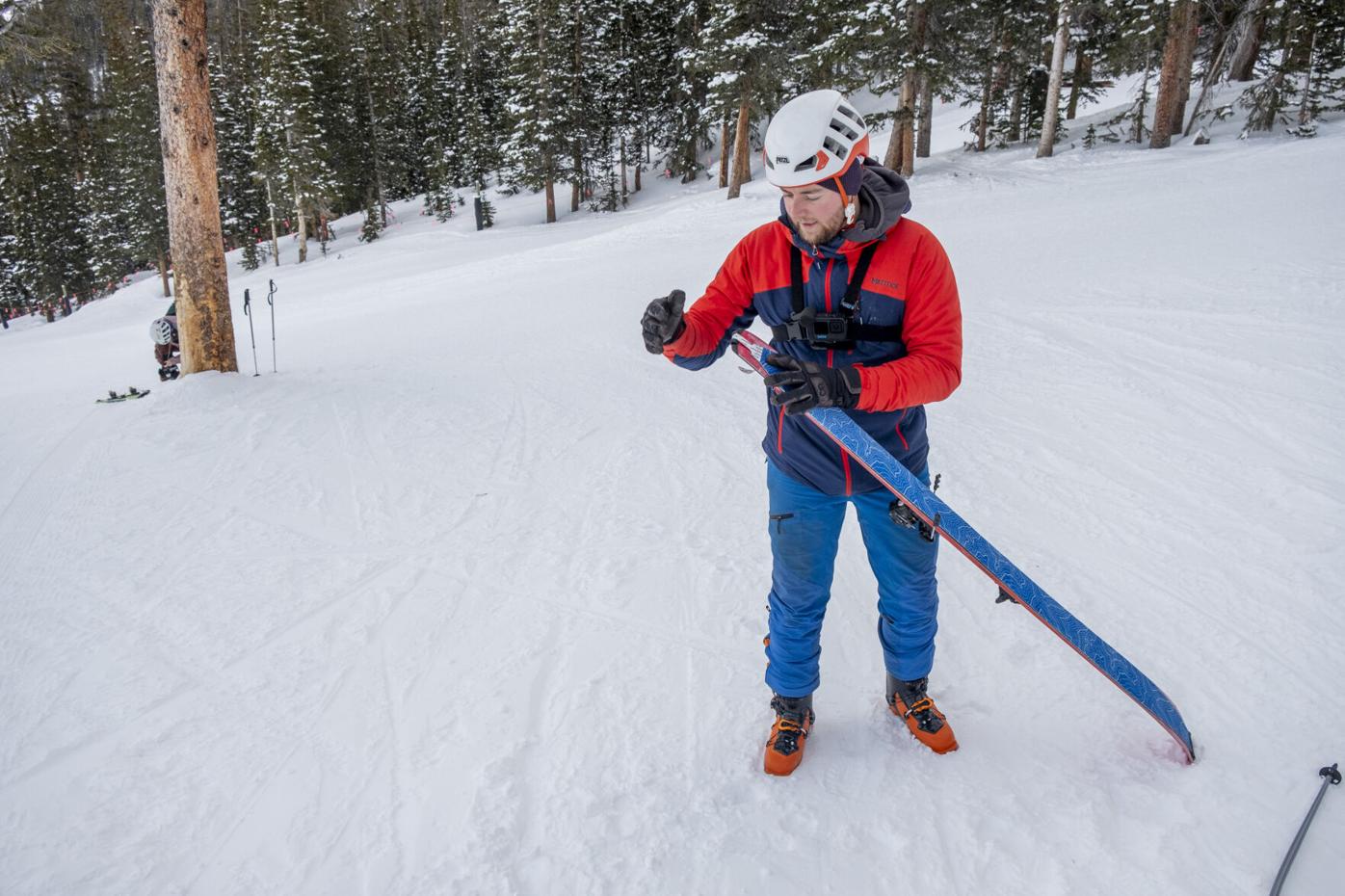
Shawn Heyland sticks his climbing skins on his AT setup while uphill skinning Tuesday, Feb. 10, 2025 at Arapahoe Basin Ski Area in Keystone, Colorado.
Jonathan Ingraham jonathan.ingraham@denvergazette.com

Shawn Heyland sticks his climbing skins on his AT setup while uphill skinning Tuesday, Feb. 10, 2025 at Arapahoe Basin Ski Area in Keystone, Colorado.
Yet regardless of setup, uphill skiing was becoming more popular.
“Alan (Henceroth) had a really good vision for this right off the bat. He supported the uphill stuff, and I helped lay out a lot of it with him,” O’Sullivan said of the rise of the activity and his involvement in helping establish uphill skiing via a pass. “We could just see that our customers, the really regular A-Basin visitors or pass holders, (to them) uphill was a portion of how they were using the hill.”
O’Sullivan started in the ski industry at Keystone Mountain in the mid-1980s before moving uphill to Arapahoe Basin for the 1989-90 season.
“In those days, you had to beg to get a ski patrol job and so I was pounding at the door and going up there and doing control routes for free and skiing around just because I wanted to work there so bad,” O’Sullivan said. “It’s definitely (been) a long, long evolution.”
O’Sullivan added another element of the uphill skiing evolution at Arapahoe Basin was when the ski area hosted ‘The Grind.’ The uphill-skiing race involved dozens of participants racing to complete a base-to-summit-to-base loop, with 4,500 feet of elevation gain and rise mixed in. The race was held for at least six years before it ended due to the race’s logistics becoming more complicated because the event was held on the weekend, according to O’Sullivan.
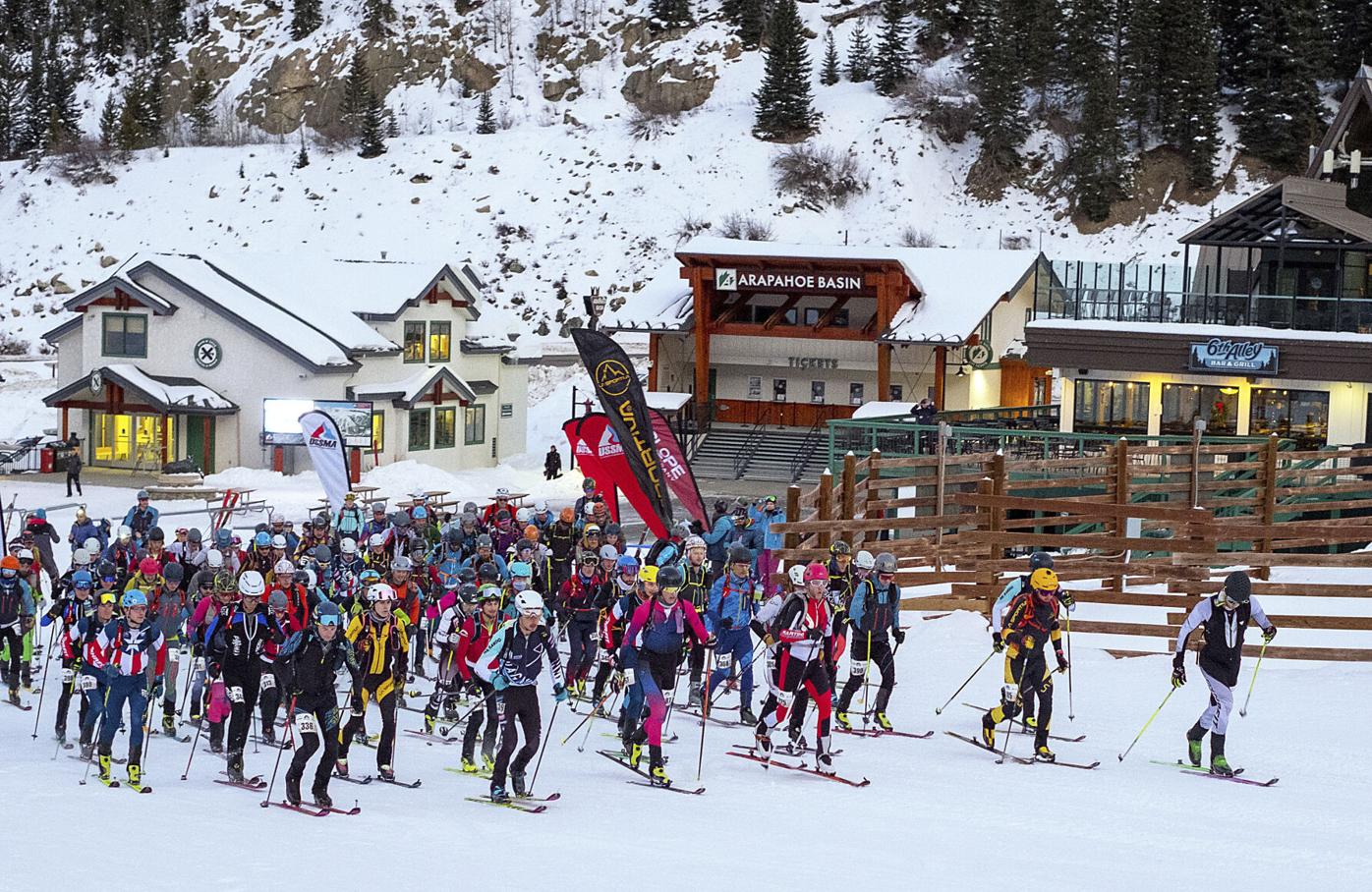
December 11, 2022: Ski mountaineering racers leave the starting line for a grueling uphill beginning to the Tour de Basin SKIMO Individual Race, A-Basin Ski Area, Frisco, Colorado (Credit Image: © Larry Clouse/CSM via ZUMA Press Wire) (Cal Sport Media via AP Images)
Larry Clouse

December 11, 2022: Ski mountaineering racers leave the starting line for a grueling uphill beginning to the Tour de Basin SKIMO Individual Race, A-Basin Ski Area, Frisco, Colorado (Credit Image: © Larry Clouse/CSM via ZUMA Press Wire) (Cal Sport Media via AP Images)
Nevertheless, uphill skiing events like ‘The Grind’ morphed into newer uphill skiing races like the ‘Rise and Shine Rando’ while also helping pave the way for greater community participation in uphill skiing.
By 2015, as many as a dozen Colorado ski areas had some type of organized uphill skiing access policy implemented, which spread to include nearly every resort by 2024.
“It’s better if you have a program in the whole system,” O’Sullivan said. “I mean, as the risk manager, I got that going because if you get a waiver from somebody and then you have a release for if they manage to hurt themselves up there, if you don’t have any kind of program, you’re more open to be sued.”
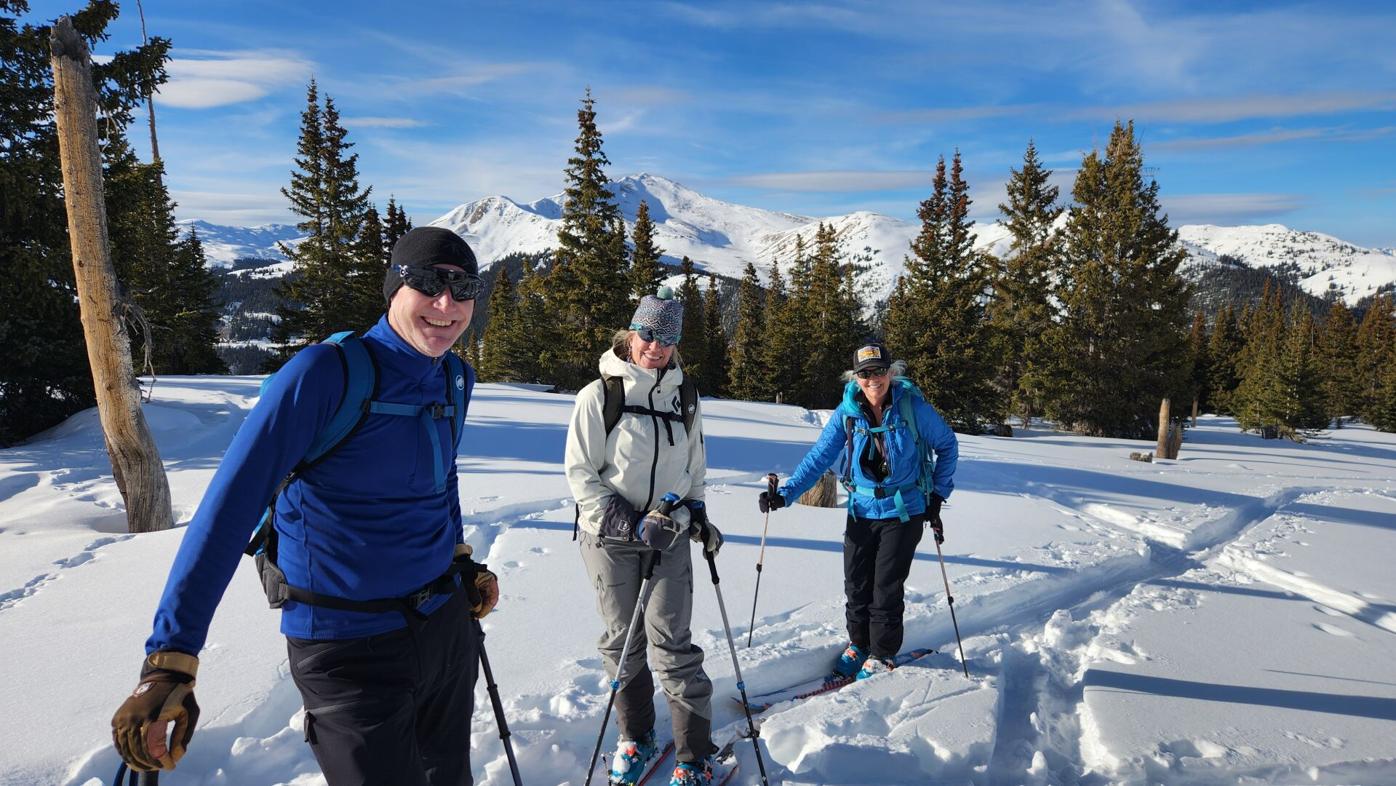
A backcountry skin day in Summit County, Colorado.
Courtesy, Patrick O'Sullivan

A backcountry skin day in Summit County, Colorado.
Even though O’Sullivan retired from the resort in 2022, he still partakes in the uphill community regularly.
How much will it cost me?
Skinning uphill to ski back down at resorts used to be free, Gina Asaorino, who has been uphilling at Arapahoe Basin for over 30 years, said.
Now, the cost of “earning your turns” at the resort varies widely.

Ski patroller Keith Miller skis near an uphill access route map on High Noon trail Tuesday, Feb. 10, 2025 at Arapahoe Basin Ski Area in Keystone, Colorado.
Jonathan Ingraham jonathan.ingraham@denvergazette.com

Ski patroller Keith Miller skis near an uphill access route map on High Noon trail Tuesday, Feb. 10, 2025 at Arapahoe Basin Ski Area in Keystone, Colorado.
At many resorts, like Copper Mountain and Eldora, uphilling is free or very discounted for season passholders. For non-passholders, the cost is steeper.
At other resorts, like Breckenridge and Keystone, uphilling is free for everyone.
Here’s the breakdown at several popular Colorado resorts:
- Winter Park: $25 for everyone
- Copper Mountain: $79 for non-passholders, $5 for Copper or IKON passholders
- Eldora: $99 for non-passholders, free for Eldora and IKON passholders
- Loveland: $50 for non-passholders, free for passholders
- Arapahoe Basin: $109 for non-passholders, $29 for Arapahoe Basin passholders
- Aspen Snowmass: $69 for everyone
- Breckenridge: free for everyone
- Keystone: free for everyone
Some resorts contribute part or all of the money they make from uphill passes to rescue operations.
At Winter Park, all proceeds from uphill skiers go to local organizations like Grand County Search and Rescue, Colorado Rapid Avalanche Deployment dog teams and Friends of Berthoud pass, according to their website.
Aspen Snowmass gives $10 from each uphill pass purchased to Mountain Rescue Aspen, their website says.
At Arapahoe Basin, $10 from each purchased pass goes to the National Forest Foundation, according to their website.
‘Stepping stone’ into the backcountry
Emma Walker, a spokesperson for the American Institute for Avalanche Research and Education, said uphill skiing inbounds can act as a stepping stone into backcountry skiing, but should never replace professional avalanche training for those interested in venturing into the backcountry.
The COVID-19 pandemic resulted in a “huge spike” in the number of people taking AIARE1, or beginner avalanche safety, courses, with people finding interest in backcountry skiing over sharing lift lines and carpools with other people, Walker said.
As more and more people take avalanche education courses, the number of resorts offering an uphill option has increased, Walker said.
While there aren’t really statistics to quantify a connection between avalanche education and inbounds uphill offerings, Walker said there’s something to be said for having inbounds uphill skiing as a ‘stepping stone’ into backcountry skiing.
Learning to manage and travel safely through avalanche terrain is vital to recreating in the backcountry in the winter, she said. So is knowing how to use the gear required to do so.
Skiing uphill inbounds before venturing into the backcountry can be a good way for a new skier to get familiar with their gear before venturing into the realm of avalanche education, Walker said.
“I think the avalanche industry has done a really good job of telling people to get an AIARE1 before going into the backcountry, but it’s also really tough to learn if you’re focused on figuring out how your bindings work, how to walk uphill on skis, how to use heel lifts and things like that,” Walker said.
“(Uphill skiing) could be a great way to familiarize yourself with the equipment and know your gear so that you can treat that as second nature and focus on learning when it comes to avalanche safety.”
Skiing inbounds is a lot safer than backcountry skiing when it comes to avalanche hazard, but no skiing is completely safe, she said. For those brand new to the concept of uphill and backcountry skiing, resorts have avalanche mitigation officials and gear, and the backcountry does not.
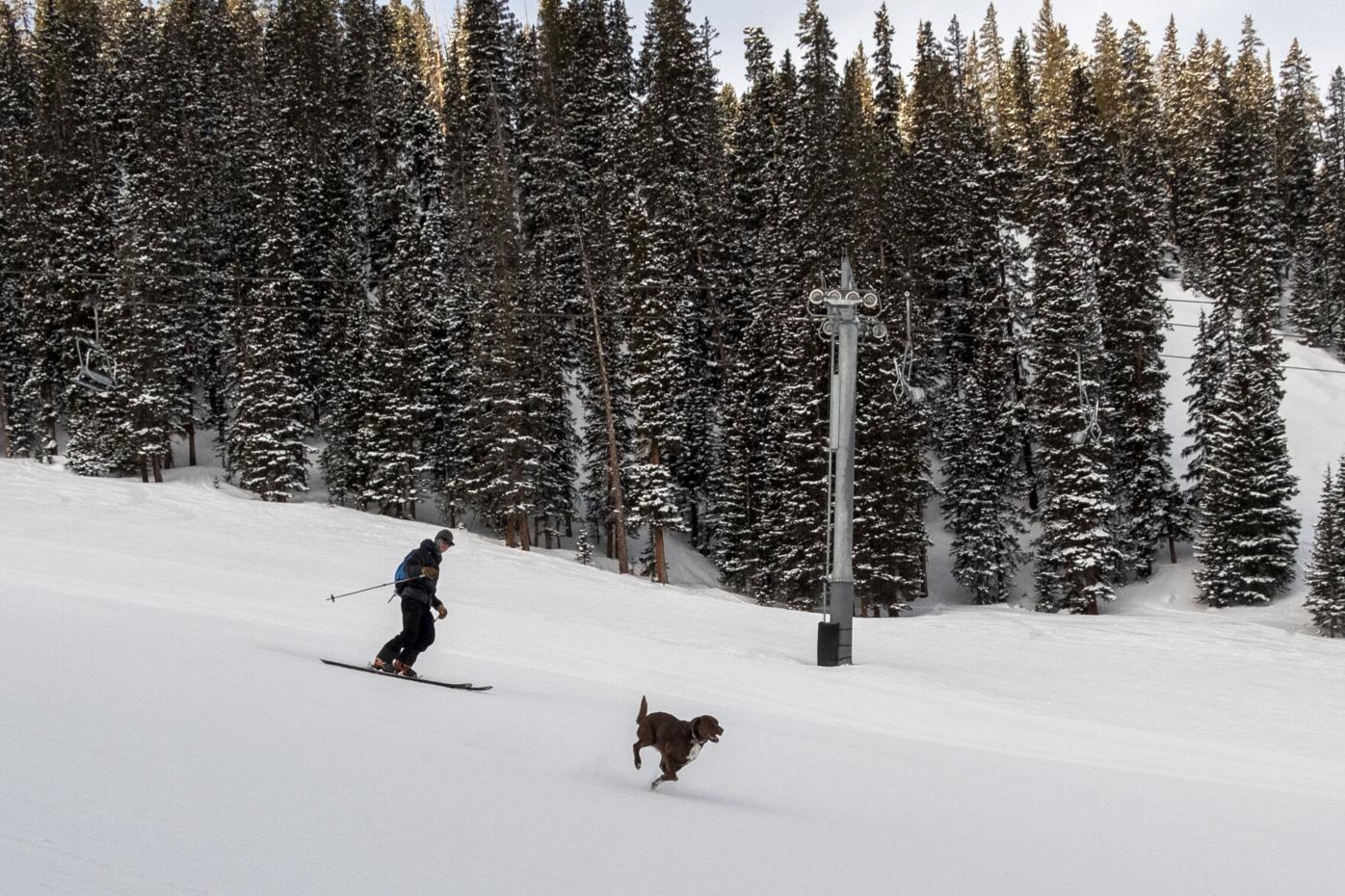
An uphill skier and his accompanying dog ski down High Noon trail Monday, Feb. 10 at Arapahoe Basin Ski Area in Keystone, Colorado.
Jonathan Ingraham jonathan.ingraham@denvergazette.com

An uphill skier and his accompanying dog ski down High Noon trail Monday, Feb. 10 at Arapahoe Basin Ski Area in Keystone, Colorado.
“There’s all kinds of ways to hurt yourself when sliding down a snowy hill,” Walker said. “But inbounds, you’re following a set track. You might be skiing steeper trails, but you don’t need to manage or think about the terrain at all. It can prepare you for the movement of skinning uphill, but it’s a really different beast than skinning uphill out of bounds.”
Inbounds uphill skiing also doesn’t require the gear backcountry skiing does, Walker said. At most resorts, a beacon, shovel and probe aren’t required to ski uphill. In the backcountry, skiers should always carry those things, she said.
While uphill skiing inbounds can be a good way to learn about the movement and gear involved in backcountry skiing, it is no substitute for avalanche education, she said.
Anyone venturing into the backcountry in the winter should have an avalanche course under their belt and the correct rescue gear, Walker said. AIARE has 114 avalanche education providers across the U.S. and a list of recreational course providers can be found on their website.
(Contact Denver Gazette Digital Strategist Jonathan Ingraham at jonathan.ingraham@denvergazette.com or on X at @Skingraham and Instagram at @Skingraham311.)





